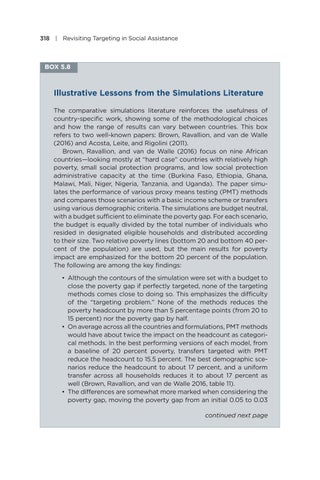318 | Revisiting Targeting in Social Assistance
BOX 5.8
Illustrative Lessons from the Simulations Literature The comparative simulations literature reinforces the usefulness of country-specific work, showing some of the methodological choices and how the range of results can vary between countries. This box refers to two well-known papers: Brown, Ravallion, and van de Walle (2016) and Acosta, Leite, and Rigolini (2011). Brown, Ravallion, and van de Walle (2016) focus on nine African countries—looking mostly at “hard case” countries with relatively high poverty, small social protection programs, and low social protection administrative capacity at the time (Burkina Faso, Ethiopia, Ghana, Malawi, Mali, Niger, Nigeria, Tanzania, and Uganda). The paper simulates the performance of various proxy means testing (PMT) methods and compares those scenarios with a basic income scheme or transfers using various demographic criteria. The simulations are budget neutral, with a budget sufficient to eliminate the poverty gap. For each scenario, the budget is equally divided by the total number of individuals who resided in designated eligible households and distributed according to their size. Two relative poverty lines (bottom 20 and bottom 40 percent of the population) are used, but the main results for poverty impact are emphasized for the bottom 20 percent of the population. The following are among the key findings: • Although the contours of the simulation were set with a budget to close the poverty gap if perfectly targeted, none of the targeting methods comes close to doing so. This emphasizes the difficulty of the “targeting problem.” None of the methods reduces the poverty headcount by more than 5 percentage points (from 20 to 15 percent) nor the poverty gap by half. • On average across all the countries and formulations, PMT methods would have about twice the impact on the headcount as categorical methods. In the best performing versions of each model, from a baseline of 20 percent poverty, transfers targeted with PMT reduce the headcount to 15.5 percent. The best demographic scenarios reduce the headcount to about 17 percent, and a uniform transfer across all households reduces it to about 17 percent as well (Brown, Ravallion, and van de Walle 2016, table 11). • The differences are somewhat more marked when considering the poverty gap, moving the poverty gap from an initial 0.05 to 0.03 continued next page


